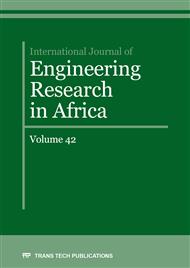[1]
A.Tafraoui, Gilles Escadeillas, Soltane Lebaili, Thierry Vidal. Metakaolin in the formulation of UHPC,. Construction and Building Materials, 23 (2009) 669–674.
DOI: 10.1016/j.conbuildmat.2008.02.018
Google Scholar
[2]
Richard P, Cheyrezy M.. Composition of reactive powder concretes,. Cement and Concrete research (1995), 25, 1501–1511.
DOI: 10.1016/0008-8846(95)00144-2
Google Scholar
[3]
YazIcI H, Yigiter H, Karabulut AIS, Baradan B. Utilization of fly ash and ground granulated blast furnace BFS as an alternative silica source in reactive powder concrete,. Fuel 2008; 87(12):2401–7.
DOI: 10.1016/j.fuel.2008.03.005
Google Scholar
[4]
Pierre-Claude Aitcin, Adam Neville, and Paul Acker: Integrated View of Shrinkage Deformation,. ACI, Volume: 19, issue: 9, (1997) 35-41.
Google Scholar
[5]
FONOLLOSA.P (2002): Propriétés Mécaniques et Microstructurales de Nouvelles Matrices à Ultra Haute Performance (MUHP),. Thèse de doctorat, Univercité de SHERBROOKE. 141 p.
Google Scholar
[6]
A. Alhozaimy, M.S. Jaafar, A. Al-Negheimish, A. Abdullah, Y.H. Taufiq-Yap, J. Noorzaei, O.A. Alawad : Properties of high strength concrete using white and dune sands under normal and autoclaved curing,. Construction and Building Materials 27 (2012) 218–222.
DOI: 10.1016/j.conbuildmat.2011.07.057
Google Scholar
[7]
Karima ARROUDJ1, Saida DORBANI, Mohamed Nadjib OUDJITand Arezki TAGNIT-HAMOU, Use of Algerian Natural Mineral Deposit as Supplementary Cementitious Materials,, International Journal of Engineering Research in Africa: (2017) 08-31.
DOI: 10.4028/www.scientific.net/jera.34.48
Google Scholar
[8]
Ehsan Ghafari, Seyed Ali Ghahari , Hugo Costa , Eduardo Júlio , Antonio Portugal , Luisa Durães. Effect of supplementary cementitious materials on Autogenous shrinkage of ultra-high performance concrete,. Construction and Building Materials 127 (2016) 43–48.
DOI: 10.1016/j.conbuildmat.2016.09.123
Google Scholar
[9]
prof. dr hab. inż. Józef Jasiczak, dr inż. Paweł Szymański, mgr inż. Piotr Nowotarski: Computerized evaluation of the early age of shrinkage in concrete,. Automation in Construction, 49 (2015) 40–50.
DOI: 10.1016/j.autcon.2014.09.001
Google Scholar
[10]
M.Bouasker, P.Mounanga, P.Turcry, A.Loukili, A.Khelidj. Chemical shrinkage of cement pastes and mortars at very early age: Effect of limestone filler and granular inclusion,. Cement & Concrete Composites 30 (2008) 13–22.
DOI: 10.1016/j.cemconcomp.2007.06.004
Google Scholar
[11]
R.K. Mishra, R.K. Tripathi, Vikas Dubey: Early age shrinkage pattern of concrete on replacement of fine aggregate with industrial by-product,. Journal of Radiation Research and Applied Sciences 9 (2016) 386 - 391.
DOI: 10.1016/j.jrras.2016.05.003
Google Scholar
[12]
Pierre Mounanga, Khalid Cherkaoui, Abdelhafid Khelidj, Mireille Courtial, Marie-Noëlle De Noirfontaine. Extrudable Reactive Powder Concretes Hydration, shrinkage and transfer properties,. European Journal of Environmental and Civil Engineering, Ed. Lavoisier, 2012, 16 (Suppl. 1), pp.s99- s114.
DOI: 10.1080/19648189.2012.681961
Google Scholar
[13]
Laplante, P., Boulay, C. Evolution du coefficient de dilatation thermique du béton en fonction de sa maturité aux tout premiers âges,. Materials and Structures, vol. 27, 1994, pp.596-605.
DOI: 10.1007/bf02473129
Google Scholar
[14]
Jensen O.M. Thermodynamic limitation of self-desiccation,. Cement and Concrete Research, vol. 25, n°1, 1995, pp.157-164.
DOI: 10.1016/0008-8846(94)00123-g
Google Scholar
[15]
ARROUDJ K, A ZENATI, M N OUDJIT1, A BALI, A TAGNIT-HAMOU. Reactivity of Fine Quartz in Presence of Silica Fume and BFS,. Engineering, 2011, 3, 569-576.
DOI: 10.4236/eng.2011.36067
Google Scholar
[16]
ZENATI.A, ARROUDJ.K, LANEZ.M, OODJIT.M.N. Influence of cementitious additions on rheological and mechanicalproperties of reactive powder concretes,. Physics Procedia 2, 2009, 1255–1261.
DOI: 10.1016/j.phpro.2009.11.089
Google Scholar
[17]
ZANNI.H, CHEYREZY.M, MARET.V, PHILIPPOT.S, NIETO.P Investigation of hydration and pozzolanic Reaction in Reactive Powder Concrete (RPC) using 29Si NMR,. Cement and Concrete Research (1996), vol. 26, n° 1, pp.93-100.
DOI: 10.1016/0008-8846(95)00197-2
Google Scholar
[18]
Cyr.M, Lawrence.P, et Ringot.E, Efficiency of mineral admixtures in mortars: Quantification of the physical and chemical effects of fine admixtures in relation with compressive strength,, Cement and Concrete Research, 36 (2), (2006), pp.264-277.
DOI: 10.1016/j.cemconres.2005.07.001
Google Scholar
[19]
MOUNANGA.P (2003), Étude expérimentale du comportement de pâtes de ciment au très jeune âge : hydratation, retraits, propriétés thermophysiques,. Thèse de doctorat, Université de Nantes, 245 p.
DOI: 10.3166/ejece.12.347-365
Google Scholar
[20]
Tarek Merzouki, Marwen Bouasker, Nour El Houda Khalifa, Pierre Mounanga Contribution to the modeling of hydration and chemical shrinkage of BFS-blended cement at early age,. Construction and Building Materials, (2013) 44, 368–380.
DOI: 10.1016/j.conbuildmat.2013.02.022
Google Scholar
[21]
F.Beltzung, F.H Wittmann, Early chemical shrinkage due to dissolution and hydration of cement,. Materials and structures (2001), Volume 34, Issue 5, p.279–283.
DOI: 10.1007/bf02482207
Google Scholar
[22]
POWERS.T.C, BROWNYARD.T.L: Studies of the physical properties of hardened Portland cement pastes – Part 3: theoritical interpretation of adsorption data,, Journal of the American Concrete Institute, vol. 18, (1946), n° 4, pp.38-48.
Google Scholar
[23]
BAROGHEL-BOUNY.V, MOUNANGA.P, KHELIDJ.A, LOUKILI.A, RAFAÏ.N: "Autogenous deformations of cement pastes: Part II. W/C effects, micro-macro correlations, and threshold values, Cement and Concrete Research, (2006) 36 (1), pp.123-136.
DOI: 10.1016/j.cemconres.2004.10.020
Google Scholar
[24]
JUSTNES, H., VAN GEMERT, A. VERBOVEN, F., SELLEVOLD, E.J. Total and External Chemical Shrinkage of Low Ratio cement Pasts,. Advances in Cement Research, (1996), 8 (31), 21-28.
DOI: 10.1680/adcr.1996.8.31.121
Google Scholar
[25]
Hamidreza Ramezani, Pierre Mounanga, Jena Jeong, Marwen Bouasker Role of cement paste composition on the self induced stress in early-age mortars: Application of the Cosserat size number,. Cement & Concrete Composites, (2013), 39, pp.43-59.
DOI: 10.1016/j.cemconcomp.2013.03.005
Google Scholar
[26]
Weiguo Shen , Xinling Li , Gejin Gan , Liu Cao , Chaochao Li , Jian Bai, Experimental investigation on shrinkage and water desorption of the paste in high performance concrete,. Construction and Building Materials, 114 (2016) 618–624.
DOI: 10.1016/j.conbuildmat.2016.03.183
Google Scholar
[27]
Zhang Wenyan, Hama Yukio and Na Seung Hyun. Drying Shrinkage and Microstructure Characteristics of Mortar Incorporating Ground Granulated Blast Furnace BFS and Shrinkage Reducing Admixture,. Construction and Building Materials. (2015), 93:267–77.
DOI: 10.1016/j.conbuildmat.2015.05.103
Google Scholar
[28]
UCHIKAW A H, HANEHAR A S, SHIRASAK A T, SAWAK I.D. Effect of Admixture on Hydration of Cement, Adsorptive Behavior of Admixture and Fluidity and Setting of fresh Cement Paste,. Cement and Concrete Research, vol. 22 (1992), pp.1115-1129.
DOI: 10.1016/0008-8846(92)90041-s
Google Scholar


